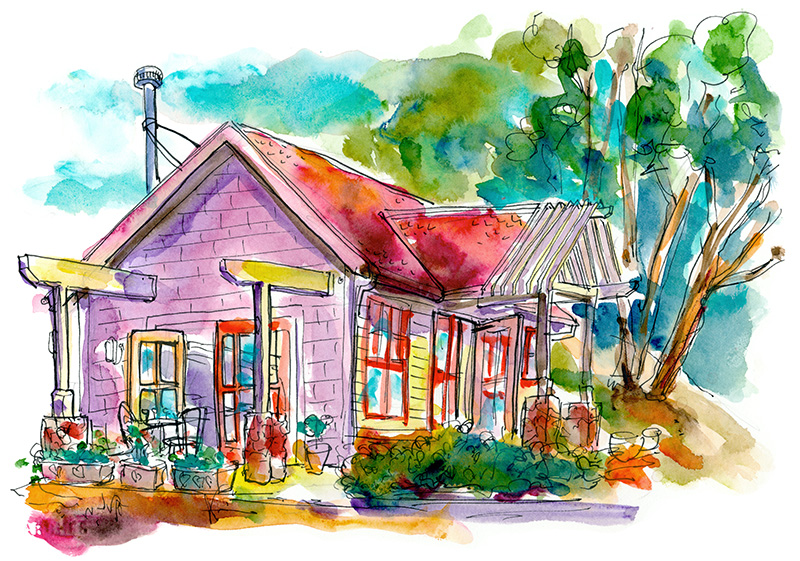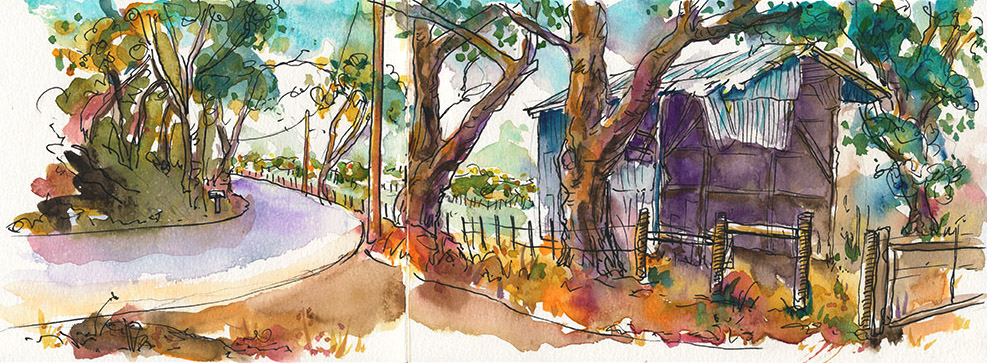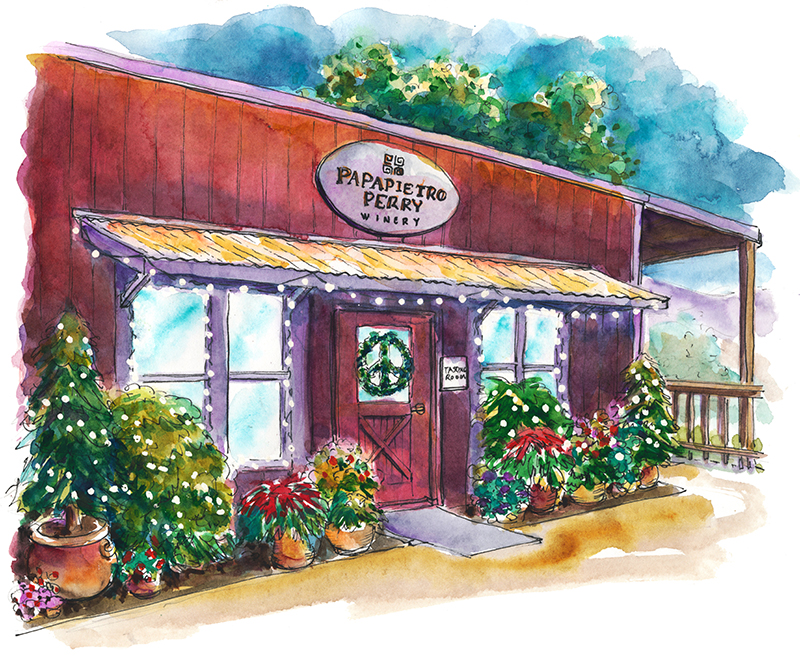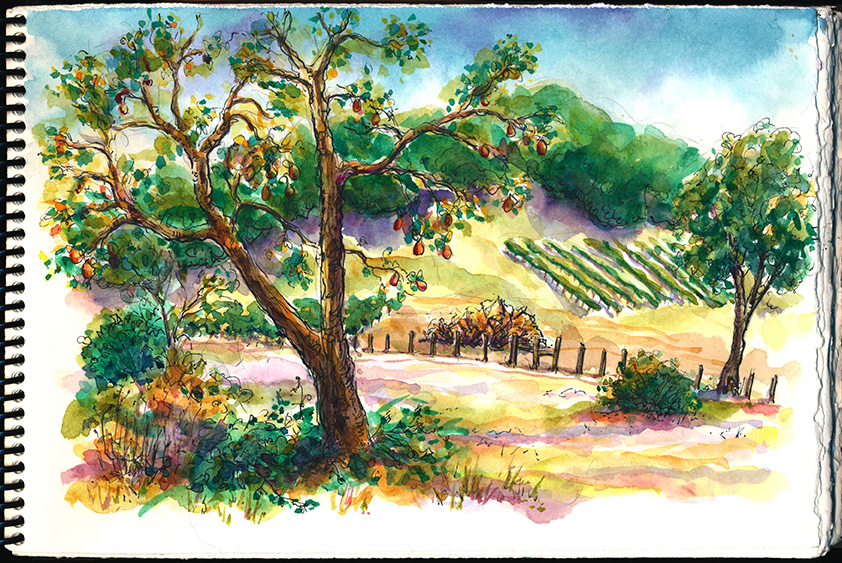
As I carried the garden hose across the yard, I could feel the pressure of the water held inside. Squeezing the nozzle’s lever, the hose relaxed as it sprayed water onto our newly planted garden. With only two weeks in the ground, I was surprised to see yellow and white flower stars adorning the greenery of our juvenile tomato, pepper, cantaloupe, and strawberry plants. I can already imagine the tasty fruits and vegetables we’ll enjoy later this summer.
While gazing at those tiny flowers, it occurred to me that I’d never seen a grape flower. Certainly, vines must bloom too. With the garden now watered, I decided to investigate at nearby Mazzocco Winery where I can walk along their vineyards and search for these unexplored blossoms. While there, I can also visit with my neighbor Charlotte, since she pours wine in the tasting room.
Because I’d be traveling by bicycle today, I entered my studio and transferred my art supplies still left in my messenger bag to my backpack. I’ve been performing this ritual quite a bit lately, since I prefer the shoulder bag when on foot or by car, but the backpack is necessary for bicycle safety. Nevertheless, it’s easy to overlook some items, so today, I decided to place pens, pencils and erasers in a separate pouch so I don’t forget or lose them in this exchange between bags.
Clouds hung low as I set out, promising cooler weather, a welcome change from the last several days of upper 90° temperatures. Hopping on my bike, a gentle breeze blew past as I made my way into Dry Creek Valley.
Today I chose a different route, one that I haven’t even driven for years, Chiquita Road. Cruising under the Redwood Highway bridge, the small town of Healdsburg opened up to rural homes, with flower beds and blackberry thickets lining the road. I scaled a couple of hills before stopping atop one to enjoy an arresting view. To the west, vineyards blanketed rolling hills with several owl houses high on posts keeping watch. To the north, the road veered westward around a small lake that serves as a gathering spot for a group of goats and one llama. To the east lies Alexander Valley, dotted with farm houses, barns and oak trees across its parched gold landscape. Even as the fog began to break, lingering clouds were still thick over the eastern valley. With a full day before me, I stopped here, leaning my bike against a fence post, to sketch and paint the scenery.

I began by wetting the page with water and then added color to the sky, being careful to leave the white of the page to suggest fog below the dusty-plum colored mountains. The Mayacama Mountains east of Alexander Valley are part of the North Coast Ranges of California, and are composed mostly of volcanic rock from the Clear Lake Volcanic Field. They separate the valleys of Sonoma and Napa, and include Mt. Saint Helena, the range’s second highest peak. In the mid-19th Century, Russians who settled in the area named the peak for their Russian princess, establishing also Fort Ross, a trading post to the west, along the Pacific Coast. In winter time, snow regularly dusts these mountains, and to my eye, gives them an even taller and more majestic air. Although I’ve yet to climb Mt. Saint Helena, I’ve heard that on a clear day, one can see San Francisco’s tallest buildings from atop.
While painting, the sun melted the remaining clouds and pushed me into the cool shade of a nearby oak tree. Sitting on a crunchy mixture of dry leaves and grasses, I finished the sketch with oak trees, grass-covered hills, and a lone barn. Then I packed up my gear and hopped on my bike, continuing along Chiquita Road. As I approached the lake, goats lifted their heads to watch me speed past.
Chiquita Road ends at Lytton Springs Road, and there I turned left, now heading west into the Dry Creek Valley proper. After about a quarter mile, Mazzocco Winery appeared on the left, but I stopped short to watch a dozen workers planting a new vineyard across the road. Starting with shovels, the men dug a hole and then placed a starter vine inside, covering the roots in dirt. A white plastic grow tube was placed around the plant to protect the tender shoots from animals such as deer, and from chilly night temperatures.

A prop plane buzzed the sky, diverting my attention. It descended slowly and disappeared behind the winery, heading to Healdsburg’s airport just beyond a hill. With a warming afternoon breeze in my face, I coasted up Mazzocco’s driveway, through the gate, and alongside the bike rack.

The area was surrounded by vineyards, their canes shooting out in all directions. A few feet from where I stood, three Mexican women in broad straw hats tended the vines and hummed a song in unison. I watched as they lifted and arranged the wild vine canes into the wire trellises above. From the head of the vine, two cordons grew in opposite directions and along them, barely distinguishable, I spotted light green fluffy clusters hanging down from the darker green leaves.

Walking over to greet the workers, I asked if they spoke English and two of the women looked worried, shaking their heads no. But the third woman replied, “yes, a little.†I pointed to one of the green fluffy clusters, asking, “flower?†Her smile indicated agreement. Upon closer look I remarked, “but the individual flowers are so small.†Here she laughed, saying “yes†again. I then asked when she expected to see grapes, but she only shook her head. At times like these I’d like to know a little Spanish. I thanked her for talking with me and the workers resumed their project.
I parked myself atop my travel stool at the edge of the vineyard, and a cool breeze attempted to fool my skin as to the true intensity of the sun’s rays. Moving in close, I saw clusters of petal-less flowers. They looked so peculiar, even whimsical to my eye, the tiny flowers bunched together to form a cluster. I began drawing in pencil, moved into ink and then finished the drawing with splashes of color.

After having spent hours in the sun with only water to quench my thirst, I was primed to taste some refreshing wine. After packing up, I headed toward the large wooden doors of the tasting room. A waft of cool air passed over me as I entered the building. I recognized my neighbor Charlotte serving wine behind the bar, who greeted me warmly in her soft Austrian voice, asking if I’d like to taste wine, then placing a glass in front of me before I could answer. Charlotte asked how I was doing, and in response, I showed her the two newly completed sketches.
“I noticed they’re replanting the vineyard across the road,” I said. “Yes,” she replied, “and for the third time in the last two years!†I asked why so many times, only to find her shaking her head with a curious uncertainty. The mysteries of wine!
As we chatted away, Charlotte poured me nine different wines, with Mazzocco’s Zinfandels standing out in their succulent, jammy fruitiness. A couple of out-of-town tasters arrived, and Charlotte set down two additional glasses. She poured wine for the new guests, and I decided to sketch her as she spoke about the wines being sampled.

I then purchased two bottles of zin and packed them up, leaving little room left in my bag. Saying goodbye to Charlotte, I hopped on my bike, backpack now heavy on my shoulders, and rode home in the afternoon sun.
 A few weeks ago I had the pleasure of tasting John Tyler wines at their new tasting room in the Russian River Valley. The delightful Nicole Bacigalupi poured their latest Pinot Noirs, Petite Syrah, and Zinfandels. I enjoyed them all and couldn’t resist purchasing a bottle of their newly released 2008 Zinfandel and their 2008 Bacigalupi Vineyard Pinot Noir. It’ll be tough to find an occasion worthy of opening a bottle, so I might just have to invent one.
A few weeks ago I had the pleasure of tasting John Tyler wines at their new tasting room in the Russian River Valley. The delightful Nicole Bacigalupi poured their latest Pinot Noirs, Petite Syrah, and Zinfandels. I enjoyed them all and couldn’t resist purchasing a bottle of their newly released 2008 Zinfandel and their 2008 Bacigalupi Vineyard Pinot Noir. It’ll be tough to find an occasion worthy of opening a bottle, so I might just have to invent one.














